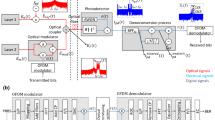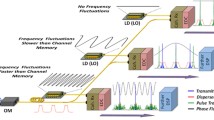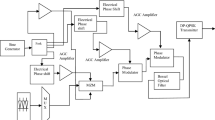Abstract
In this paper we derive the theoretical lower bound, namely Modified Cramér-Rao bound (MCRB) for symbol timing, phase and frequency offset in presence of nonlinear self-phase modulation (SPM) in a dispersion compensated long-haul coherent fiber link. The system model considers multiple span of fiber each associated with optical amplifier. Dual polarization multilevel quadrature amplitude modulation is opted for data transmission to support the data rate lower than 10 Gigabaud. We find that SPM induces underdamped oscillation on the MCRB bounds depending on the pulse shapes (symmetric and asymmetric) utilized. In presence of realistic low-pass filter at the receiver front end, the MCRB degrades significantly due to SPM. We also show the effect of SPM on symbol error rate degradation. Simulation is carried out with symmetric return-to-zero pulse with duty cycles of 33, 67 % and self-generated asymmetric pulse to verify the theoretical results.










Similar content being viewed by others
Notes
Using \({\displaystyle \sum _{k=-\infty }^{+\infty }}\left| p(\xi _{n,k})\right| ^{3}\dot{p}(\xi _{n,k})=1/T\intop _{-\infty }^{{+\infty }}\left| p(t)\right| ^{3}\dot{p}(t)\mathrm {d}t\).
References
Agrawal, G.: Applications of Nonlinear Fiber Optics. Academic Press, Elsevier (2001)
Stolen, R., Lin, C.: Self-phase-modulation in silica optical fibers. Phys. Rev. A 17(4), 1448 (1978)
Irukulapati, N.V., Marsella, D., Johannisson, P., Agrell, E., Secondini, M., Wymeersch, H.: Stochastic digital backpropagation with residual memory compensation. J. Lightwave Technol. 34(2), 566–572 (2016)
Irukulapati, N.V., Wymeersch, H., Johannisson, P., Agrell, E.: Stochastic digital backpropagation. IEEE Trans. Commun. 62(11), 3956–3968 (2014)
Du, L.B., Rafique, D., Napoli, A., Spinnler, B., Ellis, A.D., Kuschnerov, M., Lowery, A.J.: Digital fiber nonlinearity compensation: toward 1-tb/s transport. IEEE Signal Process. Mag. 31(2), 46–56 (2014)
Lau, A.P.T., Kahn, J.M., et al.: Design of inline amplifier gains and spacings to minimize the phase noise in optical transmission systems. J. Lightwave Technol. 24(3), 1334 (2006)
Ip, E., Kahn, J.M.: Compensation of dispersion and nonlinear impairments using digital backpropagation. J. Lightwave Technol. 26(20), 3416–3425 (2008)
Zibar, D., Zibar, D., Bianciotto, A., Wang, Z., Napoli, A., Spinnler, B.: Analysis and dimensioning of fully digital clock recovery for 112 gb/s coherent polmux QPSK systems. In: ECOC 2009 (2009)
Hauske, F., Xie, C., Stojanovic, N., Chen, M.: Analysis of polarization effects to digital timing recovery in coherent receivers of optical communication systems. In: 2010 ITG Symposium on VDE Photonic Networks, 2010, pp. 1–3 (2010)
Ip, E., Kahn, J.M.: Feedforward carrier recovery for coherent optical communications. J. Lightwave Technol. 25(9), 2675–2692 (2007)
Nakagawa, T., Matsui, M., Kobayashi, T., Ishihara, K., Kudo, R., Mizoguchi, M., Miyamoto, Y.: Non-data-aided wide-range frequency offset estimator for qam optical coherent receivers. In: Optical Fiber Communication Conference. Optical Society of America, p. OMJ1 (2011)
Meyr, H., Moeneclaey, M., Fechtel, S.: Digital Communication Receivers. Wiley Online Library, New York (1998)
D’Andrea, A.N., Mengali, U., Reggiannini, R.: The modified Cramer-Rao bound and its application to synchronization problems. IEEE Trans. Commun. 42(234), 1391–1399 (1994)
Tan, A.S., Wymeersch, H., Johannisson, P., Sjödin, M., Agrell, E., Andrekson, P., Karlsson, M.: The impact of self-phase modulation on digital clock recovery in coherent optical communication. In: Proceedings of European Conference on Optical Communication, ECOC 2010, Turin, Italy, September 19–23, 2010 (2010)
Sen, D., Wymeersch, H., Irukulapati, N.V., Agrell, E., Johannisson, P., Karlsson, M., Andrekson, P., et al.: MCRB for timing and phase offset for low-rate optical communication with self-phase modulation. IEEE Commun. Lett. 17(5), 1004–1007 (2013)
Sen, D.: MCRB for synchronization parameters offset in the presence of self-phase modulation in coherent optical communication. In: IEEE International Conference on Advanced Networks and Telecommuncations Systems (ANTS), pp. 1–6 (2015)
Ho, K.-P.: Probability density of nonlinear phase noise. JOSA B 20(9), 1875–1879 (2003)
Ho, K.-P., Kahn, J.M.: Electronic compensation technique to mitigate nonlinear phase noise. J. Lightwave Technol. 22(3), 779–783 (2004)
Beygi, L., Agrell, E., Karlsson, M., Johannisson, P.: Signal statistics in fiber-optical channels with polarization multiplexing and self-phase modulation. J. Lightwave Technol. 29(16), 2379–2386 (2011)
Shtaif, M.: Analytical description of cross-phase modulation in dispersive optical fibers. Opt. Lett. 23(15), 1191–1193 (1998)
Marhic, M., Kagi, N., Chiang, T.-K., Kazovsky, L.: Broadband fiber optical parametric amplifiers. Opt. Lett. 21(8), 573–575 (1996)
Ip, E., Kahn, J.M.: Power spectra of return-to-zero optical signals. J. Lightwave Technol. 24(3), 1610–1618 (2006)
Acknowledgments
The author would like to thank Prof. M. Karlsson, Prof. Erik Agrell, Prof. Henk Wymeersch, and other members of FORCE, Chalmers University of Technology for their comments and helpful discussions.
Author information
Authors and Affiliations
Corresponding author
Appendices
Appendix 1: Derivation of Fisher information for symmetric pulse without LPF
Derivation of \(F_{\theta \tau }=F_{\tau \theta }\): we see that
In (51) we used the fact that data symbols are i.i.d. and introduced \(E_{l}={\mathbb {E}}\left\{ \left\| \mathbf {S}_{n}\right\| ^{l}\right\} \). The same reasoning will be followed to derive the other components of FIM. Therefore,Footnote 1 \(F_{\theta \tau }\) is given as
Note that \(F_{\theta \tau }=F_{\tau \theta }=0\) whenever the system is linear (i.e., \(\gamma =0\)) or whenever the pulse p(t) is even.
1.1 Derivation of \(F_{\theta \theta }\) and \(F_{\tau \tau }\)
Using similar reasoning, \(F_{\theta \theta }\) is given as
Finally, it is easily shown that
Then, \(F_{\tau \tau }\) is given as
1.2 Derivation of \(F_{\theta \epsilon }=F_{\epsilon \theta }\)
Deriving \(\frac{\partial \tilde{\mathbf {x}}_{k}^{H}}{\partial \theta }\) from (12) we find that
In (56) we use the fact that \(K_{kl0}=K_{kl}\). Alternatively, in frequency domain \(F_{\theta \epsilon }\) can be given as
1.3 Derivation of \(F_{\epsilon \tau }=F_{\tau \epsilon }\)
It can be easily seen from (14) that
Hence, using (13) and (58) we obtain
Therefore,
Then, \(F_{\epsilon \tau }\) is given as
It is obvious that \(F_{\epsilon \tau }=F_{\tau \epsilon }=0\) whenever p(t) is even and the system is linear, i.e., \(\gamma =0\). Alternatively, \(F_{\epsilon \tau }\) in frequency domain is
1.4 Derivation of \(F_{\epsilon \epsilon }\)
Using (58) and (14) we derive \(F_{\epsilon \epsilon }\) as
An alternative frequency domain interpretation of (63) is
Appendix 2: Derivation of Fisher information for asymmetric pulse without LPF
We start with derivation of determinant of \(\mathbf {F}(\varvec{\Theta })\) (26)
We introduce \(A_{1,\beta }=I_{02}+2\beta ^{2}AE_{6}I_{42}\), \(A_{2}=K_{22}+2\tau K_{12}+\tau ^{2}K_{02}\), \(A_{3}=K_{131}+\tau J_{31}\), and \(A_{4}=K_{12}+\tau K_{02}\). Then,
and
Hence,
The diagonal elements of \(\mathrm {\mathbf {F}}^{-1}(\varvec{\Theta })\) in (25) are then obtained as
Substituting back into (8) MCRBs for phase, timing and frequency offset are derived.
Rights and permissions
About this article
Cite this article
Sen, D. MCRB for timing, phase and frequency estimation in presence of self-phase modulation for low-rate optical communication. Photon Netw Commun 32, 393–406 (2016). https://doi.org/10.1007/s11107-016-0667-7
Received:
Accepted:
Published:
Issue Date:
DOI: https://doi.org/10.1007/s11107-016-0667-7




